Learning Task 2
Describe Catch Basins
Catch basins are storm sewer inlets that have a specific function. Their main purpose is to collect or catch surface water from an area and direct it into a storm sewer system. Catch basins are typically found on streets, highways, parking lots, driveways, and landscape areas. They are used in areas which experience significant amounts of storm runoff, helping to collect water before it gets the chance to pool and present flooding issues. Another purpose for a catch basin is to trap or retain debris such as leaves, trash, and dirt so it doesn’t make its way into the downstream piping system, which in turn can cause pipes to clog. In this way, it acts as a form of interceptor.
Catch basins can be located on public or private property and can be found next to street curbs, in parking lots, at the bottom of sloping driveways or in the low points of residential and commercial lawn areas. Catch basins also significantly reduce the number of pollutants that enter the storm sewers.
When a catch basin become clogged, it can cause water to pool along streets, yards, and parking lots. In the minimum, this type of flooding can be an annoyance; in a worst-case scenario, the pools of water will increase to the point that they completely flood the surrounding area.
Residential drainage catch basins are usually installed at the lowest point of any area where water gathers. Properties that have uneven terrain may require multiple catch basins. Some of the benefits of having a catch basin are:
- Prevents water pooling
- Protects lawn and landscaping from water damage
- Helps route water away from a home’s foundation and driveway
- Lessens mosquito infestation and unpleasant odors from stagnant water
There are two main types of catch basins, which are curb inlet and area inlet. The curb inlet type are normally found on public roads where the roadway abuts the sidewalk. They are usually constructed of concrete and have a cast iron grate at the inlet.
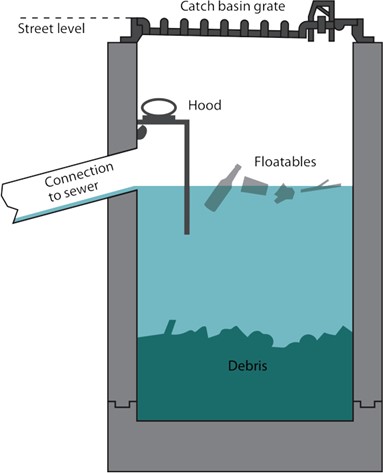
Area inlet catch basins are found on both public and private property and are normally installed at low points in paved driveways, parking areas or landscaping. Both the inlet grate and the body of residential area catch basins are normally constructed of high impact plastic, whereas the inlet grate of commercial catch basins is cast iron, with the body constructed of concrete.
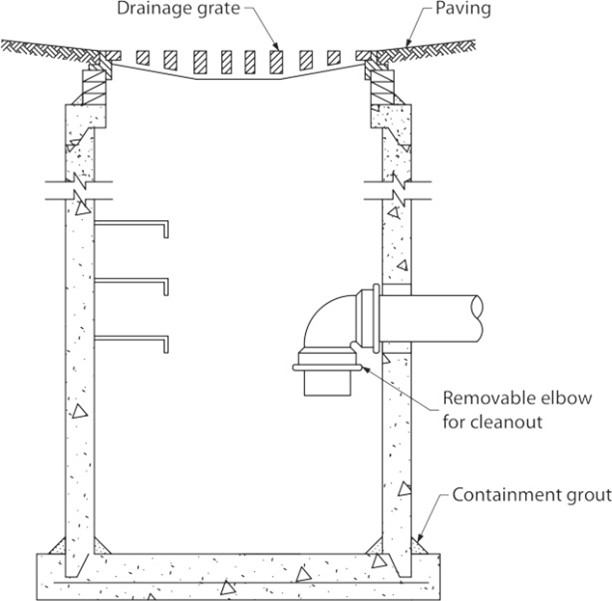
The flow from catch basins on residential properties is sometimes directed to a dry well as a point of disposal. A dry well is a large hole in the ground, usually filled with large diameter aggregate such as drain rock or “overs” (rock of > 2″ diameter) which is open to native soil on the bottom. They are an outlet for water rather than an inlet. A piping arrangement carries stormwater runoff from roofs or ground areas to the dry well, where it collects and seeps into the soil over time. Other setups use French drains to direct runoff along a natural drainage path to the dry well. The use of dry wells for storm water disposal can ease the burden on municipal storm drains, and some communities now require them. Local area regulations must be consulted before contemplating their use.
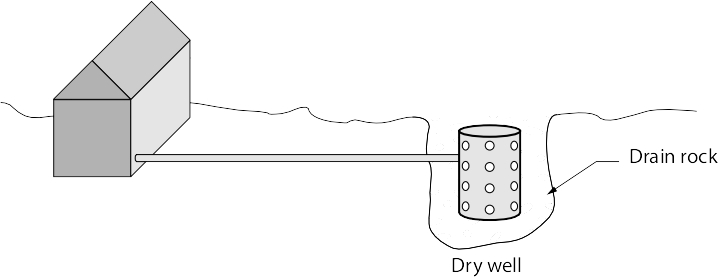
Types of Residential Catch Basins
Lawn Catch Basins
If a low point in a lawn area has poor natural drainage, a catch basin can be used to drain water away while intercepting leaves and debris. They come in various sizes of square, rectangular or round bodies and are normally made of plastic, which will normally withstand the weight of a lawnmower or lawn tractor.
Water and solids enter the box through the grate. Solids settle to the bottom while water drains out of the side through a pipe that typically connects to the larger local plumbing system and directs the water to a disposal point such as a dry well, ditch, stream, or sewage plant.
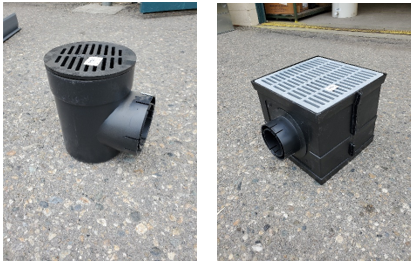
Patio and Driveway Catch Basins
Residential catch basin construction and design is similar in all the above applications, with the size and shape of the inlet grate and basin body being the differing features. Driveway catch basins and grates tend to need a more robust design than the others due to the loads imposed upon them by vehicles, however high impact plastic is the material most often used. Driveway catch basins are normally long and narrow while those meant for patios are round or square.
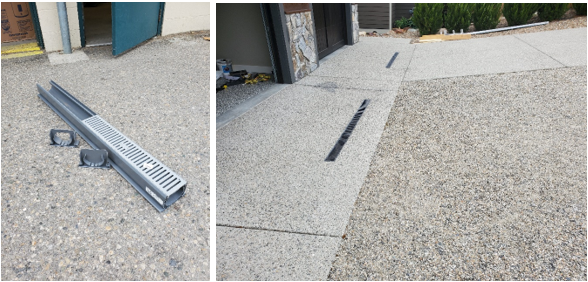
Now complete Self-Test 1 and check your answers.
Self-Test 1
Self-Test 1
- What would a manhole with a depth of 1.5m (5 ft) be classified as?
- A shallow manhole
- A normal manhole
- A deep manhole
- An extra deep manhole
- What is imbedded into pre-cast concrete manholes that are meant to allow for their lifting?
- An eccentric lid
- A cast iron grate
- Steel cable loops
- Anodized steel rungs
- What aspect of a manhole cover allows it to be used without needing a locking mechanism?
- Its weight
- Its shape
- Its colour
- Its size
- According to the NPC and regardless of its use, a manhole installed within a building must have what also installed?
- A vent
- A drain
- A locking access
- An automatic high-level alarm
- What feature of a storm manhole ensures that floating material doesn’t enter the downstream piping?
- A screen
- A trapping hood
- A backwater valve
- A very deep overall depth
- What feature of a concrete sanitary manhole is not usually found in a storm manhole?
- A ladder
- An inlet grate
- A downturned 90
- Sculpted channels
- What type of sanitary manhole may be used when its inlet and outlet piping elevations differ greatly?
- A drop manhole
- A lamp manhole
- A concrete manhole
- A composite manhole
- Besides they function to keep leaves and debris from passing into downstream piping, what are most catch basins also considered to be?
- A fixture
- An interceptor
- An appurtenance
- An unnecessary component
- What is often used on residential properties to dispose of runoff from roofs and that helps ease the burden on a municipal storm drainage system?
- A sump
- A drywell
- A catch basin
- A septic tank
- What type of catch basin has a shape that is usually long and narrow?
- A curb catch basin
- A lawn catch basin
- An area catch basin
- A driveway catch basin
Media Attributions
- Figure 1 Curb inlet catch basin by ITA is licensed under a CC BY-NC-SA licence.
- Figure 2 Area inlet catch basin by ITA is licensed under a CC BY-NC-SA licence.
- Figure 3 Dry well by ITA is licensed under a CC BY-NC-SA licence.
- Figure 4 Residential area catch basins by Greg Wirachowsky is licensed under a CC BY-NC-SA licence.
- Figure 5 Driveway area catch basins by Greg Wirachowsky is licensed under a CC BY-NC-SA licence.

